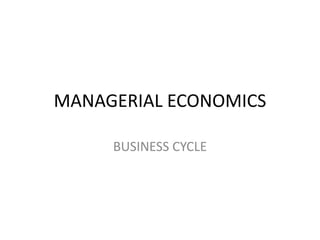
Business cycle
- 1. MANAGERIAL ECONOMICS BUSINESS CYCLE
- 2. BUSINESS CYCLE DEFINED • The phenomenon of recurring ups and downs in the levels of economic activity extending over a period of time is known as business cycle • In the simplest of the terms, a business cycle consists of a period of economic expansion followed by a period of economic contraction
- 3. CHARACTERISTICS OF BUSINESS CYCLE • Occurs periodically • International in character • Process is cumulative • Cycles will be similar but not identical
- 4. PHASES OF A BUSINESS CYCLOE • Peak • Recession • Trough • Recovery
- 5. PEAK • The stage signifies the temporary maximum of the expansionary period • Economy booming • National income high • Full employment • Consumption and investment high • Tax revenue high • Wages and profits increase • Inflationary pressure will be there. Prices rise due to brisk competition among buyers • Widespread optimism about future
- 6. RECESSION • The last stage of boom period set the stage for a recession in the economy • Output and income fall leading to reduction in consumption and investment • Tax revenue begins to fall • Wage demands moderate as unemployment rises • Import and inflationary pressure declines • Future appears to be dark and tough and general confidence level in the economy gets affected • Out of fear, people start saving more and consume less causing further fall in consumption demand, income and employment • New investment not forthcoming due to falling profits
- 7. TROUGH • At the worst stage of recession, the business activities hit a temporary bottom. This stage of business cycle is called as trough • Economic activities low • Mass unemployment • Consumption, investment and imports low • Prices may be falling • Profits are low • Confidence in the economy and its future is abysmally low • There are a few borrowers as pessimism is widespread
- 8. RECOVERY • On some positive trigger occurring, upswing in economy may take off • Trigger may come due to government stimulation of consumption spending either through tax cuts or more spending on public works, lower interest rates, increase in confidence level or any other random event • Once national income starts growing, accompanying rise in consumption spending helps sustain the momentum • General confidence level goes up
- 9. RECOVERY Contd… • Consumer credit increases because households are now more willing to borrow funds and lenders are more willing to lend • Unemployment falls • Consumption, investment and imports begin to rise • Workers demand more wages • Inflationary pressure begins to mount
- 10. THEORIES ON BUSINESS CYCLE Sunspot theory/climate theory • Depending on climatic changes agricultural products re produced • Based on production, other ancillary nits will function • Therefore, the base for any change in economic activity of the country is climate Psychological theory • During depression or crisis of any business organization, entrepreneur’s psychology as to whether the organization can be revived or shut down plays a vital role
- 11. THEORIES ON BUSINESS CYCLE Contd… Monetary theory • Demand and supply of money is the primary reason for economic fluctuations of a country Over investment theory • If the organizations and individuals save more and invest a huge amount, then their expectations are on the increase in their returns
- 12. THEORIES ON BUSINESS CYCLE Contd… Over savings/under consumption theory • The increase in savings and investment will bring down the consumption which will reduce the demand for goods in the market Innovation theory • More innovations lead to new technology and new business that leads to prosperity in the economy
- 13. TYPES OF BUSINESS CYCLE MODELS Exogenous model • The belief that economic growth arises due to influences outside he economy or company of interest • Exogenous growth assumes that economic prosperity is primarily determined by external rather than internal factors. Endogenous model • Trade cycle because of factors which lie within the economic system • Endogenous growth theory holds that investment in human capital, innovation and knowledge are significant contributors to economic growth